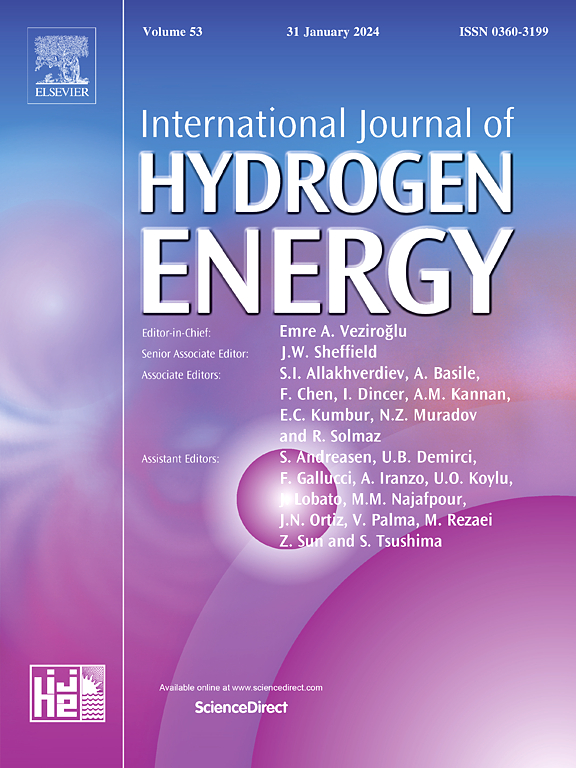Investigation on coupling mechanism of safety accident risk of hydrogen energy system based on N–K model
IF 8.1
2区 工程技术
Q1 CHEMISTRY, PHYSICAL
引用次数: 0
Abstract
The rapidly growing hydrogen energy sector faces the challenge of maximizing its clean energy benefits while managing the associated safety risks. Currently, a comprehensive understanding of the interconnected risk factors contributing to accidents remains elusive, particularly impeding the formulation of robust safety measures. Here, this study addresses this gap by employing the N–K model to elucidate the formation mechanism of coupled risks in hydrogen energy systems. Firstly, the system is divided into four subsystems: human, machine, job and management, risk factors associated with safety accidents in each subsystem are analyzed. Secondly, risks are divided into three categories: single-factor, dual-factor, and multi-factor coupling. The formation mechanism of the coupling risk is analyzed based on the concept of triggers. Thirdly, utilizing the N–K model, the internal coupling relationships and their triggers are quantitatively analyzed. The hydrogen incidents and accidents database (HIAD 2.1) was used as the main source of data, and 92 accident cases with known causes were extracted from the database based on the criterion of whether there were fatal accidents, and an example study was carried out based on the N–K model. The findings of this study reveal that the probability of safety accidents is directly correlated with the magnitude of the risk coupling value, which is influenced by the number of interacting risk factors. Significantly, the machine factor emerged as the predominant determinant of risk coupling. This study highlights the necessity for hydrogen energy systems to strengthen risk prevention mechanisms, rigorously evaluate system designs, and proactively mitigate the potential for multi-factor risk couplings. Implementing these measures will significantly enhance the overall safety of hydrogen energy systems, contributing to the development of more reliable and secure energy solutions.
基于N-K模型的氢能系统安全事故风险耦合机理研究
快速发展的氢能行业面临着最大限度地提高其清洁能源效益,同时管理相关安全风险的挑战。目前,对导致事故的相互关联的风险因素的全面了解仍然难以捉摸,特别是阻碍了制定强有力的安全措施。本研究通过采用N-K模型来阐明氢能源系统耦合风险的形成机制,解决了这一空白。首先,将系统划分为人、机、工、管四个子系统,分析了各子系统中安全事故的相关风险因素;其次,将风险分为单因素、双因素和多因素耦合三种类型。从触发器的概念出发,分析了耦合风险的形成机制。第三,利用N-K模型,定量分析了内部耦合关系及其触发因素。以氢事故与事故数据库(HIAD 2.1)为主要数据来源,以是否存在致命事故为标准,从数据库中提取出92起原因已知的事故案例,并基于N-K模型进行实例研究。研究结果表明,安全事故发生概率与风险耦合值的大小直接相关,而风险耦合值又受相互作用的风险因素数量的影响。值得注意的是,机器因素成为风险耦合的主要决定因素。本研究强调了氢能系统必须加强风险防范机制,严格评估系统设计,并主动降低多因素风险耦合的可能性。实施这些措施将显著提高氢能系统的整体安全性,有助于开发更可靠、更安全的能源解决方案。
本文章由计算机程序翻译,如有差异,请以英文原文为准。
求助全文
约1分钟内获得全文
求助全文
来源期刊

International Journal of Hydrogen Energy
工程技术-环境科学
CiteScore
13.50
自引率
25.00%
发文量
3502
审稿时长
60 days
期刊介绍:
The objective of the International Journal of Hydrogen Energy is to facilitate the exchange of new ideas, technological advancements, and research findings in the field of Hydrogen Energy among scientists and engineers worldwide. This journal showcases original research, both analytical and experimental, covering various aspects of Hydrogen Energy. These include production, storage, transmission, utilization, enabling technologies, environmental impact, economic considerations, and global perspectives on hydrogen and its carriers such as NH3, CH4, alcohols, etc.
The utilization aspect encompasses various methods such as thermochemical (combustion), photochemical, electrochemical (fuel cells), and nuclear conversion of hydrogen, hydrogen isotopes, and hydrogen carriers into thermal, mechanical, and electrical energies. The applications of these energies can be found in transportation (including aerospace), industrial, commercial, and residential sectors.
 求助内容:
求助内容: 应助结果提醒方式:
应助结果提醒方式:


